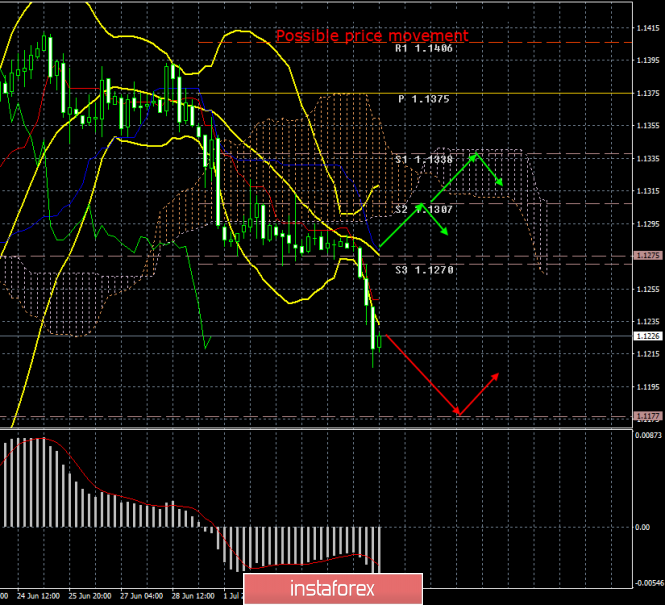4-hour timeframe

The amplitude of the last 5 days (high-low): 42p - 90p - 47p - 44p - 22p.
Average amplitude for the last 5 days: 49p (51p).
The last trading day of the current week has passed with the US currency having full advantage. There was only one reason for this - the publication of the NonFarm Payrolls report for June. Analysts' forecasts predicted 162,000 new jobs outside the agricultural sector, but in reality there were 224,000. Such a strong excess of the real value over the forecast naturally provoked strong purchases of the US dollar and so the US currency rose by 60 points against the euro. Against the background of strong NonFarms, traders ignored unemployment in the United States, which rose to 3.7%, as well as weaker wage growth than originally estimated. However, the key question for the entire currency market now is: do strong NonFarm mean the end of a period of failed macroeconomic statistics in the US or is it just an accident? As we all see, the US dollar has almost completely offset all losses against the European currency, which suffered during the month when reports from the United States could not please even the most ardent optimists. Only 120 points are left to reach the year lows and such a resurrection of the US dollar occurred, by and large, without particularly strong support from the foundation. Now a new question arises: if the macroeconomic statistics ceases to disappoint, the Fed may not soften the monetary policy in 2019, respectively, the main advantage of the euro, which bulls of the euro/dollar pair could plummet into oblivion. What should the euro count on in this case? There is no answer to this question yet, but we state the fact: the US dollar is very close to "returning to the game" and in the near future it will be possible to state the resumption of a downward trend.
Trading recommendations:
The EUR/USD pair resumed its downward movement. Thus, it is now again recommended to sell the euro with the target of 1.1177. At the beginning of the new trading week, new levels of support and resistance will be formed.
It is recommended that you buy the euro/dollar pair not earlier than when prices have consolidated above the Kijun-sen line. However, this will require a strong fundamental basis for the bulls.
In addition to the technical picture should also take into account the fundamental data and the time of their release.
Explanation of the illustration:
Ichimoku indicator:
Tenkan-sen - the red line.
Kijun-sen - the blue line.
Senkou Span A - light brown dotted line.
Senkou Span B - light purple dotted line.
Chikou Span - green line.
Bollinger Bands indicator:
3 yellow lines.
MACD Indicator:
Red line and histogram with white bars in the indicator window.
The material has been provided by InstaForex Company - www.instaforex.com